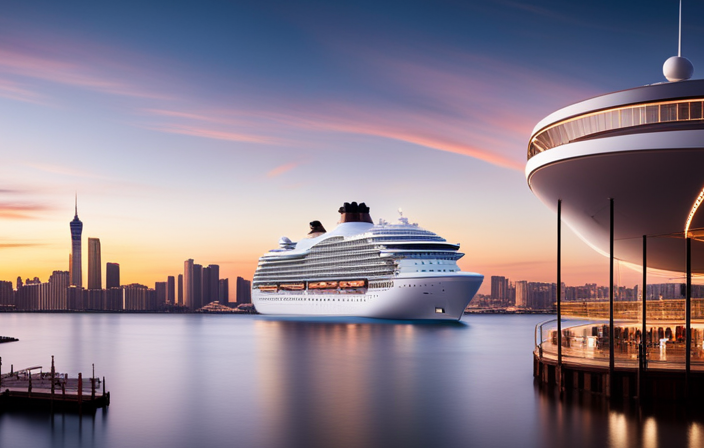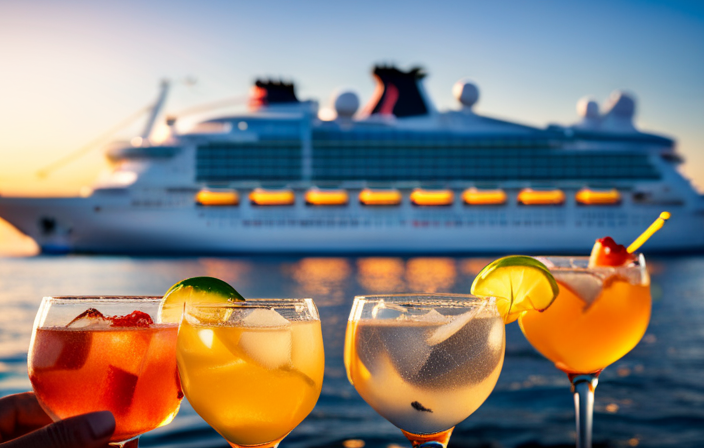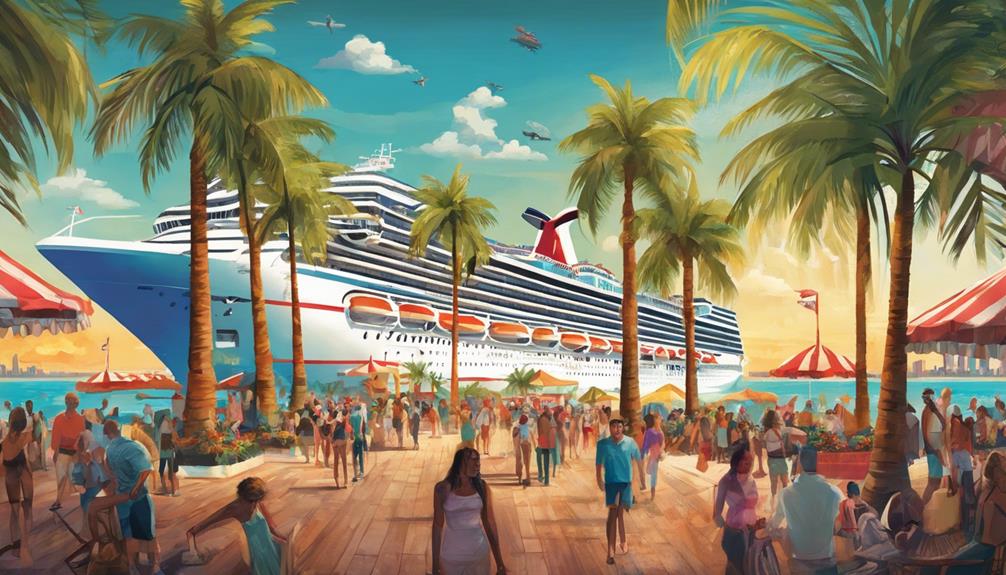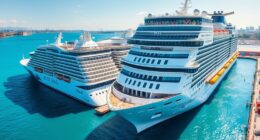Hello there! Have you ever wondered about the enormous profits that massive cruise ships generate? Brace yourself for an intriguing adventure as we delve into the lucrative world of cruising. As an enthusiastic researcher and explorer, I’ve chosen to uncover the financial secrets of these gigantic sea cities. Get ready to be astonished by the insights into the income of these magnificent vessels.
In this article, we’ll explore the size and scope of the cruise industry, the costs associated with operating a cruise ship, and the various revenue streams that keep these behemoths afloat. We’ll also delve into the impact of seasonality on profits, the economics of onboard shopping and casinos, and the crucial role played by itinerary planning.
Additionally, we’ll discuss the financial challenges and risks faced by cruise companies, as well as the future outlook for the industry.
So, grab your life jacket and join me on this data-driven journey, as we uncover just how much profit cruise ships are really making.
Key Takeaways
- Casino revenue and onboard shopping are significant factors contributing to cruise ship profitability.
- The cruise industry faces various challenges and risks such as fluctuating fuel prices, economic downturns, natural disasters, and safety concerns.
- Strategies like diversifying itineraries, maintaining strong supplier relationships, and implementing rigorous safety and health protocols are crucial to minimize risks and ensure financial sustainability.
- The integration of future technologies, such as virtual reality experiences, smart ship technology, and AI-powered personal assistants, can enhance the cruise industry’s profitability and growth.
The Size and Scope of the Cruise Industry
The cruise industry’s vast size and scope make it a lucrative business for companies. With the global cruise industry reaching a market value of over $150 billion in 2019, it is clear that there is significant profit potential in this sector.
In fact, the cruise ship market has experienced steady growth over the years, with an average annual growth rate of 6.8% from 2014 to 2019. This growth can be attributed to several factors, including increasing disposable income, a desire for unique travel experiences, and the development of new destinations and itineraries.
As we delve into the cost of operating a cruise ship, it becomes evident that these factors have contributed to the industry’s profitability.
The Cost of Operating a Cruise Ship
Operating a cruise ship can be a costly endeavor, but have you ever wondered about the expenses involved? The cost of operating a cruise ship includes various factors that contribute to the overall expenditure.
Some of the major costs include crew salaries, fuel costs, and maintenance expenses. Crew salaries account for a significant portion of the operating costs as cruise ships require a large number of employees to ensure smooth operations. From the captain to the housekeeping staff, crew members play a crucial role in providing a memorable experience to passengers.
Fuel costs also contribute to the expenses as cruise ships are massive vessels that require large amounts of fuel to navigate the open seas. With rising fuel prices, this expense can be substantial for cruise companies.
Maintenance expenses are another significant cost. To maintain a high standard of comfort and safety, cruise ships undergo regular maintenance and repairs. These costs can add up quickly, ranging from routine inspections to major renovations.
Understanding the expenses involved in operating a cruise ship provides insight into the financial challenges faced by the industry. Transitioning to the subsequent section about revenue streams for cruise companies, it is essential to explore how these costs are balanced by the profits generated.
Revenue Streams for Cruise Companies
Despite the challenges they face, cruise companies have diverse revenue streams that keep their businesses afloat. Revenue diversification is a key strategy for cruise companies, as they aim to generate income from multiple sources.
This includes not only ticket sales but also onboard purchases, such as food, beverages, and merchandise. Additionally, cruise companies often offer various packages and upgrades to entice customers to spend more during their cruise.
Pricing strategies play a crucial role in maximizing revenue, with cruise companies adjusting prices based on factors like demand, seasonality, and the popularity of specific destinations. By strategically pricing their offerings, cruise companies can optimize their revenue and profitability.
However, it is important to note that the impact of seasonality on profits is significant, as certain months and destinations may attract more passengers and generate higher revenues.
This transition into the next section highlights the importance of understanding the effect of seasonality on cruise ship profits.
The Impact of Seasonality on Profits
Seasonality has a significant influence on the financial success of cruise companies, as certain times of the year and destinations attract a higher number of passengers, resulting in increased revenue. The impact of travel restrictions on seasonal profits cannot be overlooked. For instance, during the COVID-19 pandemic, many cruise companies faced significant losses due to travel restrictions and lockdown measures. Additionally, weather conditions also play a crucial role in cruise ship profitability. Inclement weather or natural disasters can disrupt itineraries, leading to cancellations or delays, which can negatively impact the company’s financial performance. To illustrate the impact of seasonality on profits, consider the following table:
| Season | Passenger Volume | Revenue |
|---|---|---|
| Peak | High | Increased |
| Shoulder | Moderate | Stable |
| Off-Peak | Low | Decreased |
Understanding these patterns is essential for cruise companies to effectively manage their operating expenses and ensure financial stability.
Managing Operating Expenses
With careful financial navigation, cruise companies can chart a course towards smooth sailing by effectively managing their expenses. Expense management and cost optimization play a crucial role in maximizing profits for these companies.
By closely monitoring and controlling operating expenses, cruise ships can reduce unnecessary costs and increase their bottom line. This can be done through various strategies such as negotiating favorable contracts with suppliers, implementing energy-efficient technologies, and streamlining operations to eliminate waste.
Additionally, leveraging data analytics can provide insights into areas where expenses can be further optimized. By continuously evaluating and adjusting their expense management strategies, cruise companies can ensure that they are operating efficiently and maximizing their profitability.
As the next step, let’s explore the role of marketing and advertising in attracting customers and driving revenue.
The Role of Marketing and Advertising
Managing operating expenses is crucial for cruise ships to ensure profitability. However, it’s equally important for cruise ships to invest in effective marketing and advertising strategies.
In today’s digital age, social media advertising has proven to be highly effective in reaching a wide audience and generating interest in cruise ship vacations. By leveraging platforms such as Facebook, Instagram, and Twitter, cruise lines can engage with potential customers, showcase their unique offerings, and create a buzz around their brand.
Additionally, customer loyalty plays a significant role in marketing for cruise ships. By offering rewards programs, special discounts, and personalized experiences, cruise lines can foster a loyal customer base that not only returns for future trips but also advocates for their brand. This word-of-mouth advertising can be incredibly powerful and cost-effective.
Moving forward, let’s explore the economics of onboard shopping and casinos.
The Economics of Onboard Shopping and Casinos
Onboard shopping and casinos create a vibrant and exciting atmosphere, offering passengers a chance to indulge in retail therapy and try their luck at the tables. When it comes to onboard shopping trends, cruise ships have seen a significant increase in sales over the years. With a wide variety of luxury brands and duty-free items available, passengers are enticed to spend their money on these onboard retail experiences.
Additionally, casinos play a crucial role in generating revenue for cruise ships. From slot machines to table games, these onboard casinos attract passengers who are looking for entertainment and the thrill of gambling. Casino revenue analysis reveals that this sector contributes significantly to the overall profitability of cruise ships.
With onboard shopping and casinos, cruise lines can enhance the onboard experience while also boosting their profits. Transitioning to the next section, the influence of itinerary planning on profits becomes evident.
The Influence of Itinerary Planning on Profits
Imagine embarking on a cruise where every stop along the way is meticulously planned to maximize your enjoyment and ensure the ship’s financial success. Itinerary planning strategies play a crucial role in cruise ship profitability. By carefully selecting ports of call and creating unique experiences for passengers, cruise lines can attract more customers and generate higher revenues. In fact, according to a cruise ship profitability analysis, the choice of itinerary can significantly impact the bottom line. For instance, a destination with high demand and limited competition can result in increased ticket prices and onboard spending. Additionally, itinerary planning allows cruise lines to optimize fuel consumption and reduce operating costs. By strategically mapping out routes, ships can minimize distances traveled and save on fuel expenses. These data-driven decisions ultimately contribute to the overall profitability of the cruise industry. Transitioning into the next section about financial challenges and risks in the cruise industry, it is important to consider the potential impact of external factors on cruise ship profitability.
Financial Challenges and Risks in the Cruise Industry
Are you prepared for the potential financial challenges and risks that the cruise industry may face? The cruise industry isn’t immune to financial challenges, and it’s crucial for companies to have strategies in place to mitigate these risks.
Here are some potential financial risks in the cruise industry:
-
Fluctuating fuel prices: Fuel costs can have a significant impact on the profitability of cruise ships, as they heavily rely on oil. Companies need to monitor and manage fuel prices effectively to minimize costs.
-
Economic downturns: During economic recessions, discretionary spending on travel tends to decline. Cruise companies need to be prepared for potential decreases in demand during these periods.
-
Natural disasters and geopolitical events: Disruptions caused by natural disasters or political conflicts can impact cruise itineraries and lead to financial losses.
-
Safety and health concerns: Outbreaks of diseases or safety incidents on board can lead to negative publicity and a decline in bookings.
To mitigate these financial challenges, cruise companies can implement strategies such as:
-
Diversifying itineraries: Offering a variety of destinations can help minimize the impact of geopolitical events or natural disasters.
-
Building strong relationships with suppliers: Negotiating favorable contracts with fuel suppliers can help stabilize fuel costs.
-
Implementing rigorous safety and health protocols: Ensuring the safety and well-being of passengers can prevent costly incidents and maintain a positive reputation.
As the cruise industry continues to evolve, it’s essential for companies to adapt to these potential risks and implement effective strategies for financial sustainability. Looking ahead, let’s explore the future of cruise ship profits and industry growth.
The Future of Cruise Ship Profits and Industry Growth
Get ready for an exciting glimpse into the future of the cruise industry, where you’ll discover how you can be a part of the remarkable growth and profitability that lies ahead.
The cruise industry is continuously evolving and adapting to meet the demands of modern travelers. One key aspect of this evolution is the integration of future technologies. Cruise lines are investing in cutting-edge innovations such as virtual reality experiences, smart ship technology, and AI-powered personal assistants to enhance the guest experience and attract new customers.
Additionally, environmental sustainability is a top priority for the industry. Cruise companies are actively exploring and implementing eco-friendly initiatives, such as using cleaner fuels, investing in energy-efficient technologies, and reducing waste.
By embracing these future technologies and prioritizing environmental sustainability, the cruise industry is poised for continued growth and profitability in the years to come.
Frequently Asked Questions
How do cruise ships generate revenue from onboard activities such as spa services and specialty dining?
Cruise ships generate revenue from onboard activities such as spa services and specialty dining. Spa revenue is generated through services like massages and facials, while specialty dining revenue comes from premium dining options that guests can choose to purchase.
What are some of the major financial risks that cruise companies face?
Major financial challenges for cruise companies include market fluctuations, which can impact demand and pricing, as well as operational costs like fuel and labor. These risks require careful financial planning and management to ensure profitability.
How do cruise companies manage and allocate their marketing budgets?
Cruise companies manage and allocate their marketing budgets by implementing data-driven marketing strategies. This involves conducting target audience analysis to identify the most effective channels for reaching potential customers and optimizing their marketing investments accordingly.
What factors contribute to the seasonality of profits in the cruise industry?
Seasonal demand and economic factors greatly impact the cruise industry’s profits. According to a study, cruise lines experience a surge in profits during peak vacation seasons, with an average increase of 20%.
How do cruise companies determine the prices of their cruise packages and onboard amenities?
Cruise companies determine cruise package pricing and onboard amenities pricing through careful analysis of market demand, operating costs, and competitive pricing. Factors such as itinerary, ship amenities, and customer preferences are considered to establish profitable pricing strategies.
Conclusion
In conclusion, the cruise industry continues to be a profitable business, with cruise ships generating significant revenue.
One interesting statistic is that in 2019, the global cruise industry reached a record $46 billion in revenue, showcasing its economic impact.
However, it’s important to note that managing operating expenses, seasonality, and financial risks pose challenges to the industry.
Despite these challenges, the future looks promising, with industry growth expected to continue as cruise companies adapt to changing consumer preferences and expand their offerings.










